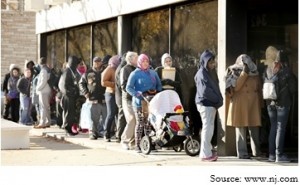DC is facing a big tech glitch which could disrupt access to health coverage for thousands of Medicaid beneficiaries’ through next spring, unless quick action is taken. As a result of the glitch, many residents will have to complete a long and complex form and bring it in person to one of DC social services eligibility centers, which already face overcrowding and other challenges. DC’s health officials should move quickly to create temporary ways to work around the tech issues and limit the need to do paper work and in-person visits to the service centers. Without action, it is likely that many residents will unnecessarily lose health coverage.
The District is updating its outdated computer system for Medicaid and other public benefits. It holds great promise for making Medicaid and other programs easier to apply for, including allowing Medicaid beneficiaries to renew online through an automated process — without filling out paper work or coming into a service center. These “passive” renewals started in January 2015, and about half of beneficiaries are able to get through the process without taking additional steps.
However, a technology glitch in the system will not allow passive renewals to continue until late next spring. Starting in January, anyone who wants to renew their Medicaid benefits will have to fill out a 17-page paper form. That means that the Economic Security Administration (ESA), which manages the service centers that process public benefits, will see a large uptick in the number of people and amount of paper work coming in. In the past, influxes of paperwork and people at ESA have led to:
- Client confusion, especially since many have not had to renew in person over the last two years
- Long wait and processing times at the service centers
- Unsecure and lost documents during processing at service centers
- Wrongful termination of benefits and gaps in health coverage
Technology glitches are bound to happen in a big IT rollout, but it is the District’s responsibility to ensure that those eligible for Medicaid keep and maintain their health coverage. This means creating work-arounds for beneficiaries that limit traffic at the services center. A couple of options include:
- Eliminating unnecessary eligibility requirements in other public benefit programs that increase traffic at ESA — including the DC Healthcare Alliance six-month face-to-face interview requirement. Data show that the requirement is a huge barrier to keeping eligible residents enrolled and unnecessarily increases foot traffic at service centers.
- Taking up federal options to confirm someone’s Medicaid eligibility based on participation in other programs. For example, if the District knows that a resident is on SNAP or food stamps, they can use that to automatically confirm the resident is likely eligible for Medicaid.
- Enlisting community health centers more in the eligibility and enrollment process. Getting more of the process done outside of the service centers will limit congestion and processing problems.
To print a copy of today’s blog, click here.
